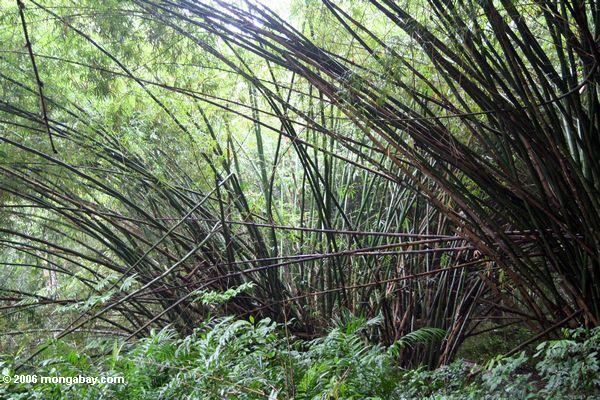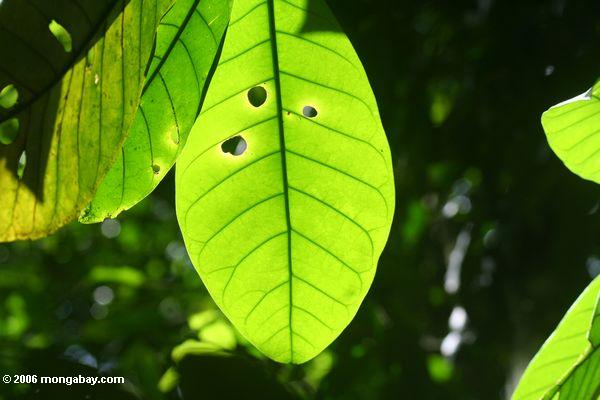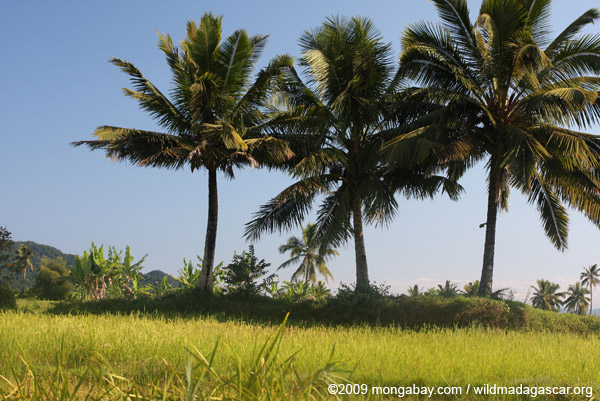The death of global biodiversity
APPRECIATING THE BENEFITS OF PLANT BIODIVERSITY
By John Tuxill
From "State of the World, 1999." Copyright í 1999, Worldwatch Institute. Publication is available from Worldwatch Institute, 1776 Massachusetts Avenue, N.W., Washington, D.C. 20036. http://www.worldwatch.org

Colombia
BIO-UNIFORMITY RISING
The cumulative effects of human activities on Earth are evident not just in declines in particular species, but in the increasingly tattered state of entire ecosystems and landscapes -- and when large-scale ecological processes begin to break down, conservation and management become all the more complicated. Take the problem of habitat fragmentation, when undisturbed wildlands are reduced to patchwork, island-like remnants of their former selves. Natural islands in oceans or large lakes tend to be impoverished in species; their smaller area means they usually do not develop the ecological complexity and diversity characteristic of more extensive mainland areas. Moreover, when an island population of a species is eradicated, it is harder for adjacent mainland populations to recolonize and replace it.

Deforestation for palm oil production in Indonesia
As a result, when development -- large-scale agriculture, settlements, roads -- sprawls across landscapes, remaining habitat fragments usually behave like the islands they have become: they lose species. In western Ecuador, the Río Palenque Science Center protects a square-kilometer remnant of the lowland rainforest that covered the region a mere three decades ago; now the center is an island amid cattle pasture and oil palm plantations. Twenty-four species of orchids, bromeliads, and other plants at Río Palenque have already succumbed to the "island effect" and can no longer be found there. One vanished species, an understory shrub, has never been recorded anywhere else and is presumed extinct.
Even with these drawbacks, small areas of native habitat can have enormous conservation value when they are all that is left of a unique plant community or rare habitat. But waiting to protect them until only patches remain carries an unmistakable tradeoff: smaller holdings require more intensive management than larger ones. In smaller reserves, managers often must simulate natural disturbances (such as prescribed burns to maintain fire-adapted vegetation); provide pollination, seed dispersal, and pest control services in place of vanished animals; reintroduce desirable native species when they disappear from a site (perhaps due to a series of poor breeding seasons); and perform other duties the original ecosystem once did free of charge. Governments and societies that are unwilling or unable to shoulder these management costs will soon find that the biodiversity they intended to protect with nature reserves has vanished from within them.

Invasive species that crowd out native flora and fauna are one of the biggest headaches for managing biodiversity in disturbed landscapes. In certain susceptible habitats, such as oceanic islands and subtropical heathlands, controlling invasives may be the single biggest management challenge. South Africa has one of the largest invasive species problems of any nation, and has a great deal at stake: the fynbos heathlands and montane forest of the country's Cape region hold more plant species -- 8,600, most of them endemic -- in a smaller area than anywhere else on Earth. Fortunately, South Africans are increasingly aware of the threat that exotics pose, and in 1996 the government initiated a program to fight invasives with handsaw and hoe. Some 40,000 people are employed to cut and clear Australian eucalypts, Central American pines, and other unwanted guests in natural areas. It is a measure of the scale and severity of the invasive problem that this effort is South Africa's single largest public works program.
Large-scale ecological alterations also have great potential to combine their effects in unpredictable and damaging ways. For instance, much of the world is now saturated in nitrogen compounds (an essential element required by all plants for growth and development) because of our overuse of nitrogen-based synthetic fertilizers and fossil fuels. Studies of North American prairies found that the plants that responded best to excess nitrogen tended to be weedy invasives, not the diverse native prairie flora. Likewise, plant and animal species already pressed for survival in fragmented landscapes may also have to contend with altered rainfall patterns, temperature ranges, seasonal timing, and other effects of global climate change.

Already, scientists are detecting what could be the first fingerprints of an altered global atmosphere on plant communities. Data from tropical forest research plots worldwide indicate that the rate at which rainforest trees die and replace each other, called the turnover rate, has increased steadily since the 1950s. This suggests that the forests under study are becoming "younger," increasingly dominated by faster-growing, shorter-lived trees and woody vines -- exactly the kinds of plants expected to thrive in a carbon dioxide-rich world with more extreme weather events. Without major reductions in global carbon emissions, forest turnover rates will likely rise further, and over time could push to extinction many slower-growing tropical hardwood tree species that cannot compete in a carbon-enriched environment.

Deforestation in Madagascar
Global trends are shaping a botanical world that is most striking in its greater uniformity. The richly textured mix of native plant communities that evolved over thousands of years is increasingly frayed, replaced by extensive areas under intensive cultivation or heavy grazing, lands devoted to settlements or industrial activities, and secondary habitats -- partially disturbed areas dominated by shorter-lived, "weedy," often nonnative species. A 1994 mapping study by the organization Conservation International estimated that nearly three quarters of our planet's habitable land surface (that which is not bare rock, drifting sand, or ice) already is either partially or heavily disturbed. Moreover, within human-dominated landscapes, relatively diverse patchworks of small-scale cultivation, fallow fields, seasonal grazing areas, and managed native vegetation are being replaced by large, uniform fields or by extensive denuded and degraded areas.

The mixtures of species in different regions are becoming more similar as well. Lists of endangered plants are dominated by endemic species -- those native to a relatively restricted area such as a country or state, an isolated mountain range, or a specific soil type. When endemic plants vanish, the remaining species pool becomes more uniform. Finally, the spectrum of distinct populations and varieties within plant species is shrinking, a problem most advanced in our endowment of domesticated plants.
Countries that emerged in a world filled with biodiversity now must gain and maintain prosperity amid increasing bio-uniformity. We are conducting an unprecedented experiment with the security and stability of our food supply, our health care systems, and the ecological infrastructure upon which both rest. To obtain the results we desire, we must conserve and protect the plant biodiversity that remains with us, and manage our use of natural systems in ways that restore biodiversity to landscapes worldwide.

Deforestation in the Amazon rainforest in Brazil
STORED FOR SAFEKEEPING
Broad recognition of the need to safeguard plant resources is largely a twentieth century phenomenon. The first warnings about the global erosion of plant diversity were voiced in the 1920s by scientists such as Harry Harlan of the United States and Nikolai Vavilov, who realized the threat posed by farmers' abandonment of landraces in favor of newer varieties that were spreading widely in an increasingly interconnected world.
The dominant approach to conserving plant varieties and species has involved removing them from their native habitat or agricultural setting and protecting them at specialized institutions such as botanical gardens, nurseries, and gene banks. Most off-site collections of wild species and ornamental plants are in the custody of the world's 1,600 botanical gardens. Combined, they tend representatives of tens of thousands of plant species -- nearly 25 percent of the world's flowering plants and ferns, by one estimate.

Palm oil plantation
Most botanical gardens active today were established by European colonial powers to introduce economically important and ornamental plants throughout the far-flung reaches of empires, and to promote the study of potentially useful plants. Nowadays many botanical gardens have reoriented their mission toward species preservation, particularly in their research and education programs. Since the late 1980s, botanical gardens have coordinated efforts through an international conservation network, which helps ensure that the rarest plants receive priority for propagation and, ultimately, reintroduction.
Gene banks have focused almost exclusively on storing seeds of crop varieties and their immediate wild relatives. (The principal exception is the Royal Botanic Garden's Millennium Seed Bank in England, which holds more than 4,000 wild species and is expanding toward a collection of one quarter of the world's flora.) Gene banks arose from plant breeders' need to have readily accessible stocks of breeding material. Their conservation role came to the forefront in the 1970s, following large losses linked to genetic uniformity in the southern U.S. corn crop in 1970 and the Soviet winter wheat crop of 1971-72.

Rice and palms in Madagascar
In 1974, governments and the United Nations established the International Board for Plant Genetic Resources (now known as the International Plant Genetic Resources Institute, or IPGRI), which cobbled together a global network of gene banks. The network includes university breeding programs, government seed storage units, and the Consultative Group on International Agricultural Research (CGIAR), a worldwide network of 16 agricultural research centers originally established to bring the Green Revolution to developing countries, and funded primarily by the World Bank and international aid agencies.
The number of unique seed samples or "accessions" in gene banks now exceeds 6 million. The largest chunk of these, more than 500,000 accessions, are in the gene banks of CGIAR centers such as the International Rice Research Institute in the Philippines and the International Wheat and Maize Improvement Center (CIMMYT) in Mexico. At least 90 percent of all gene bank accessions are of food and commodity plants, especially the world's most intensively bred and economically valuable crops. By the late 1980s, IPGRI regarded a number of these crops, such as wheat and corn, as essentially completely collected; that is, nearly all of the known landraces and varieties of the crop are already represented in gene banks. Others have questioned this assessment, however, arguing that the lack of quantitative studies of crop gene pools makes it difficult to ascertain whether even the best-studied crops have been adequately sampled.

Deforestation in the Amazon
There are additional reasons for interpreting gene bank totals conservatively. The total annual cost of maintaining all accessions currently in gene banks is about $300 million, and many facilities, hard-pressed for operating funds, cannot maintain seeds under optimal physical conditions. Seeds that are improperly dried or kept at room temperature rather than in cold storage may begin to lose viability within a few years. At this point, they must be "grown out" -- germinated, planted, raised to maturity, and then reharvested, which is a time-consuming and labor-intensive activity when repeated for thousands of accessions per year. These problems suggest that an unknown fraction of accessions is probably of questionable viability.
Only 13 percent of gene-banked seeds are in well-run facilities with long-term storage capability -- and even the crown jewels of the system, such as the U. S. National Seed Storage Laboratory, have at times had problems maintaining seed viability rates. For extensively gene-banked crops (primarily major grains and legumes) where large collections are duplicated in different facilities, the odds of losing the diversity already on deposit are reduced. But for sparsely collected crops whose accessions are stored at just one or two sites, the possibility of genetic erosion remains disquietingly high.

Fig tree in Indonesia
Despite such drawbacks, offsite facilities remain indispensable for conservation. In some cases, botanical gardens and gene banks have rescued species whose wild populations are now gone. They can also help return diversity to its proper home through reintroduction programs. Although the uplands of East Africa are not the center of domestication for common beans, the farmers of the region adopted them as their own several centuries ago, and have developed the world's richest mix of local bean varieties. When Rwanda was overwhelmed by civil conflict in 1994, the height of the genocidal violence occurred during the February-to-June growing season, greatly reducing harvests and raising the prospect of widespread famine. Amid the relief contributions that flowed into the country once the situation had stabilized were stocks of at least 170 bean varieties that had been previously collected in Rwanda and stored in gene banks worldwide. These supplies helped ensure that Rwandan farmers had stocks of high-quality, locally adapted beans for planting in the subsequent growing season.
Still, even the most enthusiastic boosters of botanical gardens and gene banks recognize that such facilities, even when impeccably maintained, provide only one piece in the conservation puzzle. Offsite storage takes species out of their natural ecological settings. Wild tomato seeds can be sealed in a glass jar and frozen for safekeeping, but left out of the cold are the plant's pollinators, its dispersers, and all the other organisms and relationships that have shaped the plant's unique evolution. Gene banks and botanical gardens only save a narrow -- albeit valuable -- slice of plant diversity. When stored seeds are grown out over several generations offsite, in time they can even lose their native adaptations and evolve to fit instead the conditions of their captivity.
Previous | Next










